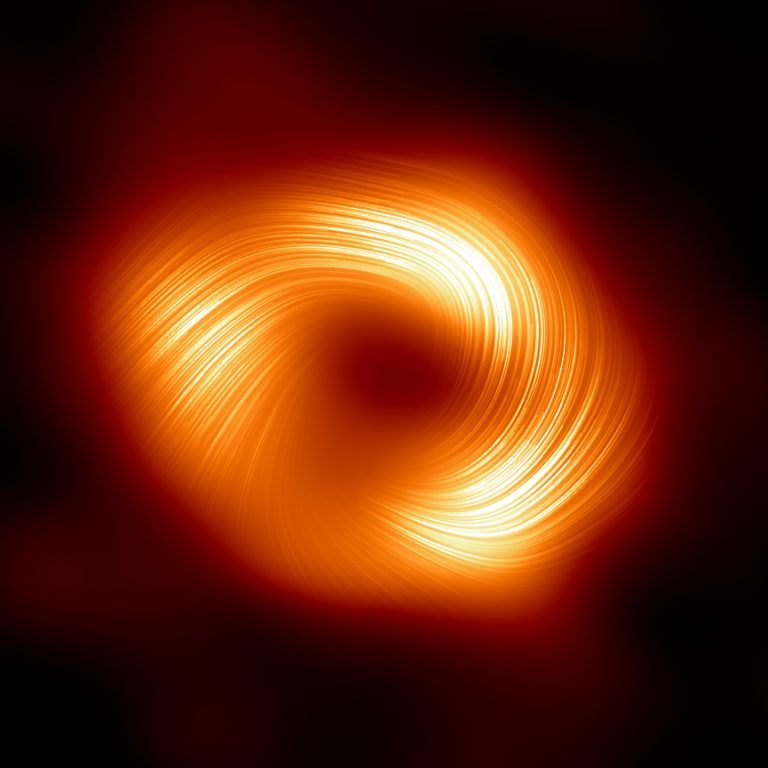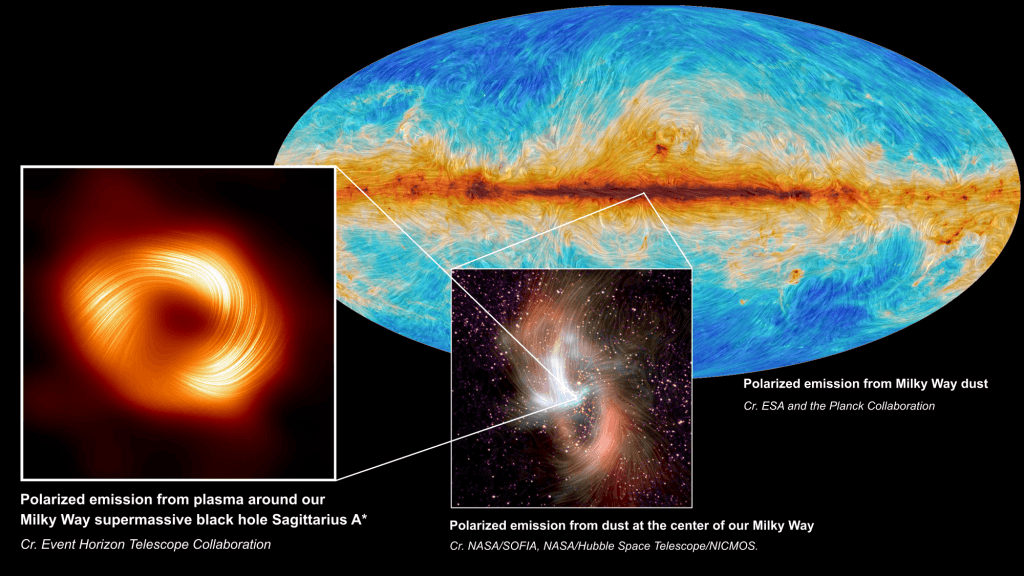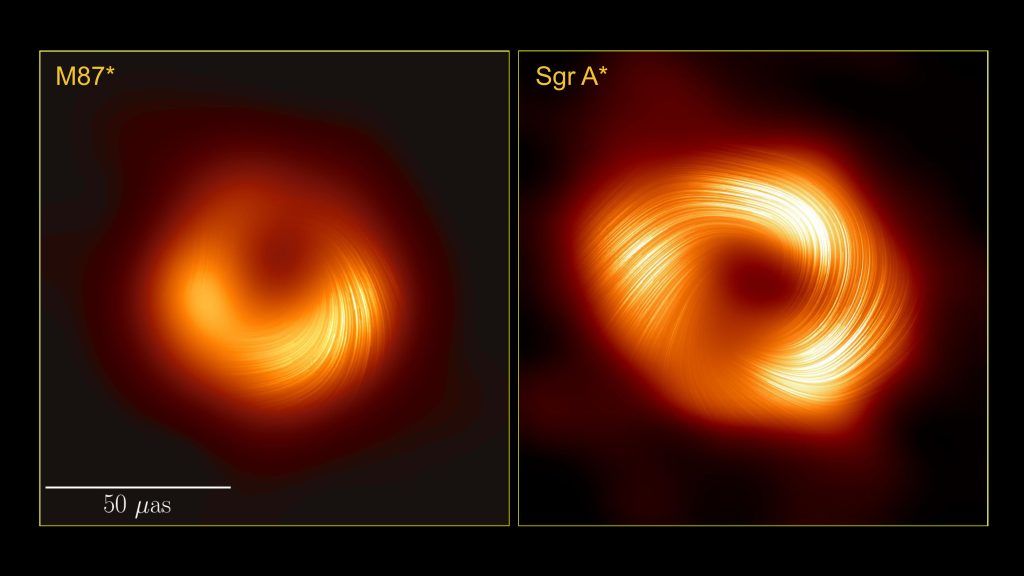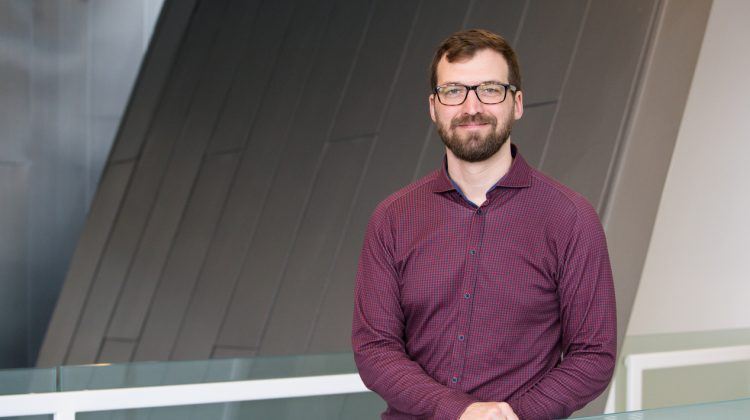Canadian scientists help unveil powerful magnetic fields clothing the Milky Way’s central black hole
Astronomers capture polarized light from the supermassive black hole at the heart of our galaxy in unprecedented detail.

If you’ve ever tried to photograph a fast-moving preschooler, then you’ve experienced some of what it’s like to take a picture of the black hole at the centre of our galaxy. The unruly maelstrom, which astronomers call Sagittarius A* (SgrA*), shifts and changes hour-to-hour as hot plasma swirls around it. What’s more, pesky layers of interstellar plasma between Earth and the black hole block our view, making it difficult to capture a clear image.
Despite the challenges, scientists managed to snap that first photo, unveiling it in 2022.
Today saw the release of new SgrA* images, revealing not just the plasma ring, but also the magnetic field lines that shape and organize it. The results were released across two papers in The Astrophysical Journal Letters, one revealing the new observations and the other interpreting the data. The new observations confirm our best theories about how supermassive black holes grow and evolve, providing a firm empirical foundation for the science of galactic evolution and extreme gravity environments.
It took some significant ingenuity to pull off, and Canadian scientists, as part of the global Event Horizon Telescope (EHT) collaboration, played a crucial role in making it happen.
“SgrA* is like a frenetic toddler,” says Avery Broderick, Associate faculty at Perimeter Institute and the University of Waterloo. “But we’ve managed to overcome the challenges posed by its variability, and the results are really exciting. We’re seeing for the first time the invisible structure that shepherds material within the black hole’s disk and drives plasma to the event horizon, helping the black hole grow.”
Broderick and his team are the experts behind THEMIS, a framework for analyzing the data that the EHT collects. Imaging with THEMIS has been a game-changer in black hole astronomy, providing solutions to two significant challenges scientists faced when trying to image SgrA* with confidence.
First, THEMIS offers a way to reliably assess the credibility of any given image of the black hole. The EHT can’t capture all the light from SgrA*: some gaps need to be filled via extrapolation. But that means there are multiple possible images consistent with the data. THEMIS helps sift through these possibilities. It works like this: instead of narrowing down the options to just one picture, THEMIS explores all the possible images, giving precise probabilities for which features in them are real, and which are noise in the machine. In doing so, THEMIS reduces the risk of misinterpreting the data, and provides a reliable statistical method for studying the information SgrA* sends us from across the galaxy.
Second, THEMIS offers a way to image SgrA* even though the black hole refuses to sit still. SgrA*’s swirling plasma is always churning away, changing on short timescales. With THEMIS, astronomers were able to model the “noise” in the data and provide an estimate for it, letting them “cancel it out” to produce a clear, time-averaged image of SgrA* in spite of its rapid variability.
Combined, these two breakthroughs enabled the EHT team to reliably interpret what they see happening around SgrA*, despite the furious variability of the plasma ring.
So, what did they find? The new results reveal strong polarization patterns in the signals that SgrA* emits.
Polarization – a property describing the orientation of light wave oscillations – is the same principle that sunglasses take advantage of to dim intensity by blocking light waves oriented in one or more directions.

The waves the EHT receives from SgrA* come mostly in the form of synchrotron radiation – that is, emissions from high-energy electrons zipping around the black hole’s magnetic field lines. Synchrotron emissions tend to be polarized perpendicular to the magnetic field that they originated in. By measuring the polarization, in other words, scientists are able to measure the structure and strength of SgrA*’s magnetic fields.
“The polarized light we see from SgrA* is striking,” says Broderick. “Not only is it highly polarized – three times more polarized than the black hole at the centre of the M87 galaxy – but it’s also highly organized. This new image limits the density of the plasma orbiting Sgr A* and reveals the magnetic fields that govern its fate.”

According to astronomers’ best models of black hole evolution, the magnetic fields in the accretion disk need to be strong enough to push the accreting plasma around. The new results from SgrA* (and those from its much larger cousin M87* previously) provide the first direct observational evidence to support those models: we’re seeing these black holes “eat” in real-time.
This new research marks a milestone in black hole astronomy, telling the story of black hole evolution, and bringing the unruly core of our galactic neighbourhood into sharp focus.

























































































